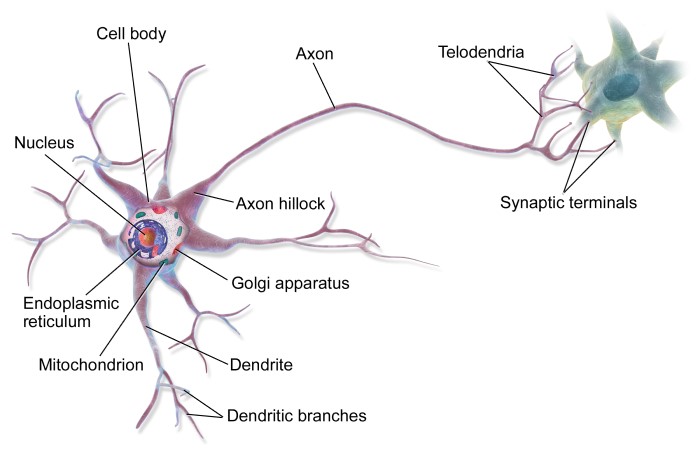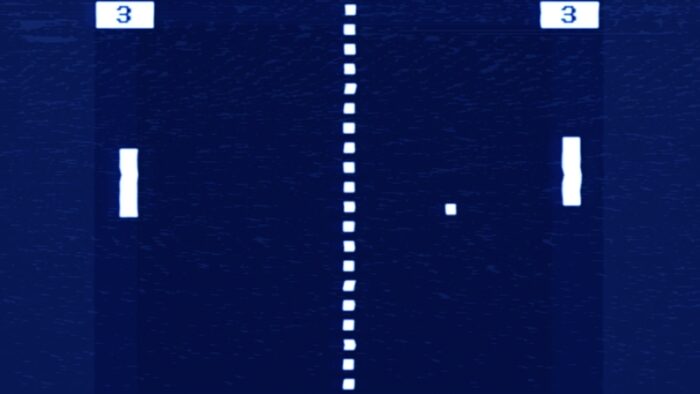In 1972, one of the first commercially available video games was introduced. Called Pong and based on table tennis, it was simple to play and understand.
A 'ball' bounced back and forth across the screen. On either side, two 'paddles' could be moved up and down to hit the ball back toward the centre. If the ball got past your paddle, the other player got a point. Simple!
Now, fifty years later, this video game is being used as a training exercise for a dish full of brain cells.
Wait? What? "A dish full of brain cells"?
A new study by Cortical Labs in Melbourne, Australia has trained about 800,000 brain cells to play a version of Pong. Though the brain cells are not quite an example of artificial intelligence, they are providing a window into how our brain cells work and what they are capable of.
What is a DishBrain?

This electron microscope image shows the different brain cells. They have been dyed with fluorescent markers. The neurons are purple. Also in the dish are dentrites and axons, which act as connecting fibres to and from neurons. (Cortical Labs)
DishBrain is the nickname that the researchers at Cortical Labs have given a Petri dish full of brain cells. (A Petri dish is a palm-sized, shallow round dish that is used in experiments to hold cultures, or collections, of organic matter for study.) These brain cells are also known as neurons. The dish had about 800,000 neurons. That may sound like a lot, but in your own brain, you have about 86 billion neurons. Wow!
What do neurons do?

This is a diagram of a typical neuron. Electrical information flow in and out of it, carrying information (and instructions) across the body's nervous system. (Wikimedia Commons)
We have a few different types of neurons in our brains. But generally, neurons are what receive and process outside information (known as stimuli) in our brains. For example, when we touch something hot or see an object moving toward us, neurons receive that information and then get our bodies to respond to the situation. (In this case, by removing our hand from the hot thing, or getting out of the way of what is approaching us.)
This information travels between neurons as electricity along fibres called dentrites (to the neuron) and axons (away from the neuron). Neurons receive and send this electrical information so quickly—and naturally—that we barely register what is happening. We just do. But these neurons make billions of tiny decisions everyday to keep us safe and sound.
How do these brain cells play a video game?
Joined together as a network in our brain, neurons get the job done. They are a miraculous living computer. But they have also been designed by billions of years of evolution to function together as a unit.
The question being asked by the researchers in this study was: Could a bunch of random neurons be trained to respond to signals and 'learn' how to complete a task? In other words, play Pong.
To test this, researchers set up the neurons so that they had a certain role in playing the game. They sent a series of electrical pulses across one area of neurons to represent where the 'ball' was moving. This was the stimuli (Hey, neurons! The ball is moving this way!). Meanwhile, another section of neurons was able to 'move' the paddle so that it could meet the ball and hit it back.
That felt nice!
The last part of the experiment was maybe the trickiest. How could you train DishBrain to understand when it 'hit' or 'missed' the ball?
Studies have shown that neurons like a 'predictable response'. You can think of it as receiving positive feedback from a friend, parent, or teacher. They responded well when I did that thing—I'm going to try and do it again!
In this case, when the ball was 'missed', the neurons received a very unpredictable and random electrical response. But when they 'hit' it, they received the exact same electrical pulse, and in the exact same spot, every time.
It's almost like the equivalent of training a dog and giving it a treat every time it performs the task! Here are the results ...
What are the benefits?
Though this experiment is pretty impressive, Pong isn't exactly a difficult game (and DishBrain plays it very, very slowly). So why does this experiment matter?
The researchers at Cortical Labs believe that they can use this type of set up to test how neurons respond in different conditions. And that they can do it without needing to use living humans (or animals) as test subjects.
This could be a very big deal. Currently, any potentially life-saving drug must ultimately be tested on humans to see how well it works (and whether it has any negative side effects). DishBrain is not a replacement for human brain. Not yet, anyway. But at some point, something like it could be an excellent alternative to using living test subjects.
And even a dish of neurons can figure out that that is a really useful thing!
 Pong was one of the earliest video games. And it's making a comeback ... sort of! (ID 189681644 © Grenar | Dreamstime.com)
Pong was one of the earliest video games. And it's making a comeback ... sort of! (ID 189681644 © Grenar | Dreamstime.com)










I couldn’t believe that this was possible and this could be a break through for the human understanding of the brain. I hope when I am older I can see the nureons being scientifically advanced so we save the process of experimentation of using live people or animals. This will be better and safer for our world.
Thank you so much for sharing this break through because I found it to be a very facinating experiment. I look forward to hearing more about this in the future.